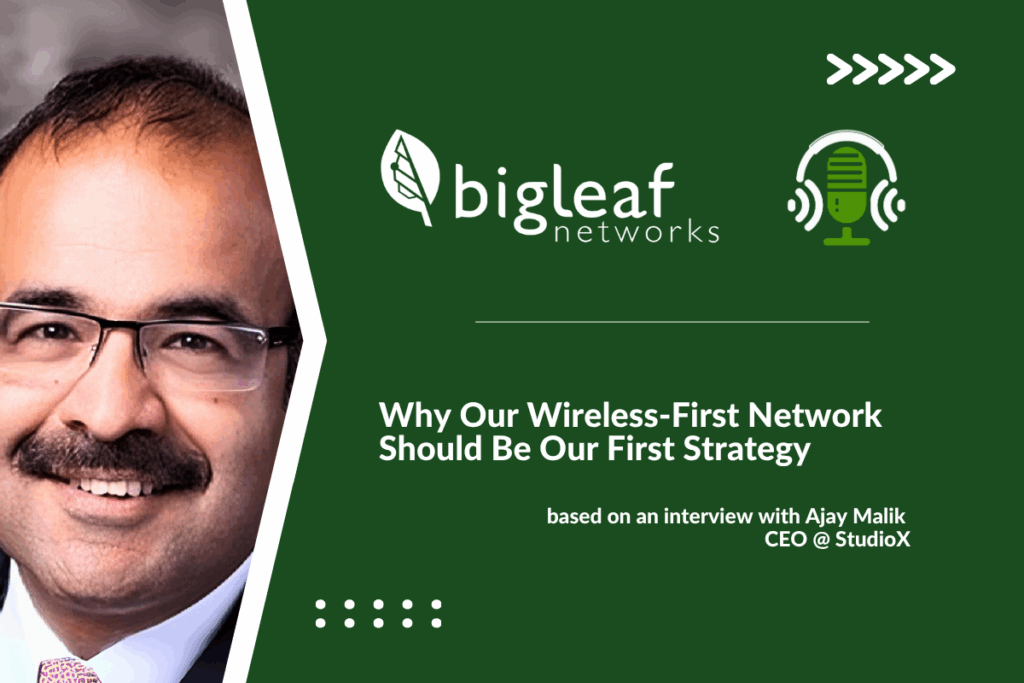Wireless networks used to be viewed as a convenient add-on, bridging gaps until fiber arrived. Ajay Malik argues those days are gone. In his conversation on Go Beyond the Connection, he explains how Wi-Fi and AI have matured into a single growth engine that accelerates deployment, slashes CapEx, and unlocks customer experience gains wired networks can’t touch. Adopting a wireless-first growth strategy, today’s leaders must reframe connectivity from plumbing to a profit center—or risk falling behind.
Wireless-First: From Cost Center to Growth Catalyst
Ajay frames Wi-Fi as an executive-level growth lever rather than an IT preference. Removing trenching and cabling from new-site projects slashes deployment timelines, allowing retailers, manufacturers, and healthcare providers to open revenue-generating locations weeks sooner. The capital that would have paid for construction can be reinvested in product launches, marketing campaigns, or M&A activity.
Equally important, wireless access points scale without incremental physical disruption. Organizations can add capacity or reconfigure layouts overnight, supporting pop-up stores, hybrid offices, or temporary facilities without project delays. When speed to revenue becomes the metric, Wi-Fi’s flexibility constantly outperforms fixed-line alternatives.
Reliability Reimagined
Skeptics often recall first-generation Wi-Fi outages and assume the risks remain. Ajay concedes those early struggles but notes that seventh- and eighth-generation standards now deliver deterministic performance that rivals fiber. Adaptive radios negotiate congestion automatically, while predictive algorithms prevent interference from escalating into downtime.
Because stability concerns have faded, the larger risk remains tethered to cables that limit change. Wired backbones cannot evolve quickly when customer demand or competitive pressure shifts. Ajay believes leadership teams should compare today’s wireless metrics—latency, packet loss, and throughput—directly against their wired estate; the numbers usually favor Wi-Fi.
AI Elevates Customer Experience
Ajay links connectivity directly to customer satisfaction and revenue. He observes that attention spans now hover below ten seconds; users abandon carts or close apps at the first hint of buffering. AI-enabled Wi-Fi classifies traffic in real time, prioritizing mission-critical applications without manual rule-writing.
Beyond performance, wireless-first networks open doors to contextual engagement. Loyal guests can auto-connect when they enter a store or hotel, avoiding friction and signaling premium service. By treating every network interaction as a CX touchpoint, brands convert reliable bandwidth into higher Net Promoter Scores and incremental spend.
Preparing for Autonomous Networks
Ajay expects a rapid shift toward self-healing networks orchestrated by cooperating AI agents. These agents will monitor backbone health, local radio conditions, and client behavior—executing corrective actions autonomously. Early adopters can expect fewer support tickets, faster root-cause isolation, and consistent quality of experience across sites.
The workforce implications are significant. Routine break-fix duties will shrink, enabling engineers to focus on policy design, security analytics, and strategic innovation. Today, organizations that cultivate data-science skills and experimentation will own the learning curve when autonomy becomes table stakes.
Why Wireless-First Delivers Growth You Can Measure
The wired-versus-wireless debate no longer hinges on reliability; it revolves around opportunity cost. Ajay Malik urges decision-makers to stop asking whether Wi-Fi can keep up and start exploring how it multiplies growth potential. Companies that embrace a wireless-first, AI-driven mindset will enjoy faster deployments, richer customer experiences, and talent freed to tackle tomorrow’s competitive challenges.
Based on a podcast interview with Ajay Malik, CEO of StudioX.
Let’s Go Beyond the Connection — explore more:
- 🎵 Listen on Captivate
- 📖 Episode Page on Bigleaf
- 📽️ Watch on YouTube
- 📬 Subscribe to the LinkedIn Newsletter
Related Links:
- 📖 Bigleaf Networks Launches AI-Powered Risk Monitoring
- 📘 New! Bigleaf Wireless Connect
- 📡 Wireless-First is Key to Seamless Enterprise Connectivity
- 🤖 AI Reasoning: Game Changer for Autonomous Networks
